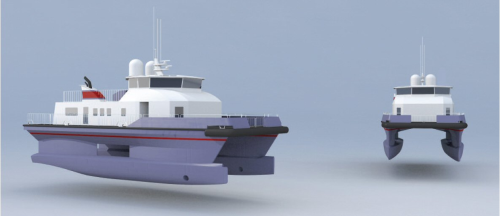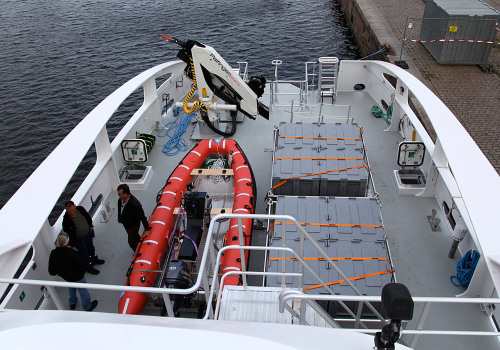

In Part 1 of this feature we reviewed some of the companies choosing composites to manufacture wind farm service vessels (WFSVs). In Part 2 we asked if composite vessels can withstand conditions for offshore. In this final part we look at the use of carbon composite in these vessels.
Carbon
While GRP is well established in the offshore wind sector, carbon composite is also making inroads where the economic case can justify it. Carbon, already in substantial use for localised strengthening applications, is now being adopted for primary hull, deck and other structures.
Scandinavian Shipbuilder Kockums AB and associate Fintry Marine Design AG of Switzerland, claim that their CarboClyde catamaran was the first commercial catamaran to be built entirely in carbon fibre reinforced plastic (CFRP). The hulls and other assemblies such as the wheelhouse of the 23.6 m carboCAT are sandwich structures produced in Sweden in female moulds. Kockums fabricated the carbon fibre/vinyl ester skinned DIAB Divinycell cored structure using the vacuum-assisted resin infusion technique it has developed over a number of years for its military (notably the Visby class) and other vessels.
| CarboCAT has calculated that over a 10-year period the carbon vessel would use 20% less fuel than an aluminium equivalent. |
The UK-flagged DNV-classified craft can carry up to 24 passengers and was first deployed at the Baltic1 wind farm off Germany. The foredeck carries a Palfinger crane or can be equipped with a docking system for the safe transfer of service personnel between the vessel and offshore structures.
CarboCAT, the entity formed to market a family of carbon composite catamaran workboats, has calculated that over a 10-year period the carbon vessel would use 20% less fuel than an aluminium equivalent and that this, combined with a superior lifespan, should more than compensate for extra initial expense.
Another advantage pointed out by the company is that a composite vessel, especially one based on carbon as the lightest form of composite, is less likely to damage an offshore structure in any collision than a heavier metal craft. It argues that the sandwich structure absorbs impact energy and localises vessel damage to a particular area that is then amenable to repair.
Another trailblazer for carbon is the SeaStrider SWATH catamaran produced in infused carbon/epoxy composite by Danish Yachts AS. This company has applied carbon composite expertise gained in the superyacht field to produce a 25 m WFSV capable of carrying up to 24 passengers and five crew at a service speed of 21 knots.
Like CarboClyde, the Danish Yachts competitor is intended for carrying installation and maintenance staff to wind farms well offshore and has a cruising range of 500 miles. As well as relying on its SWATH characteristic to ease motions at sea, the craft has an active ballast tank system, enabling ballast water to be pumped between tanks to enhance stability on transfer to and from turbine towers. Consequently operations can continue in significant wave heights of up to 2.5 m, says the company.
According to Fredrik Odfjell, director of Norwegian customer Offshore Windservice ApS: “We are extremely pleased to be working with Danish Yachts in the build of this series of wind turbine service vessels, with their depth of experience and know-ledge in innovative carbon construction. A key factor for our support fleet is stability in a large seaway and the ability to transfer between towers at speed in severe conditions, vastly reducing downtime for maintenance teams while on operational duties at wind farms.”
Another advantage of the low weight made possible by its carbon fibre construction is that, using brackets that are part of the structure, the vessel can be taken out of the water in a single-point lift for transfer ashore or to an offshore platform.
Danish Yachts professes to be totally committed to advanced composite, having perceived a market opportunity and being determined to seize it. It says that its carbon composite craft will cover substantial distances at speed even in rough conditions and will be able safely to transfer to wind towers personnel who have traveled in comfort and are not impaired by seasickness. Ability to operate in significant wave heights of some 2.5 m will enlarge weather windows during which operation will be possible, helping wind farm operators to support profitability by minimising turbine downtime.
Business development manager Morten Lorenzen expresses his company’s intention to refine the technology still further so that operations can continue in waves up to 3m Hs. Such capability would enable operators to access North Sea installations for 310 days a year, as distinct from the average 200 days/year possible with the 1.5 m capability that most current WFSVs are certified for.
Composite vs metal
Clearly, in the WFSV sector where the twin-hull catamaran form dominates, the battle between composites and metal (aluminium) has been well and truly joined and this is likely to rage for some time to come.
One possible outcome is that ‘standard’ composites may triumph in near shore applications where conditions are less extreme and fuel economy may trump repairability considerations, but also in the far offshore zone where the fuel consumption and emissions advantages of advanced composite craft outweigh other considerations and can justify the purchase price premium such vessels require. This could leave metal to dominate in mid-distance operations where lower acquisition costs might more than compensate for extra expenditure on fuel during service life.
Whatever the eventual outcome, there is currently a burgeoning need for more and increasingly capable WFSVs. This is bringing useful business opportunities for composite workboat builders and the associated supply chain. ♦
This feature was also published in the November/December 2012 issue of Reinforced Plastics magazine.
The digital edition of Reinforced Plastics is distributed free of charge to readers who meet our qualifying criteria. You can apply to receive your free copy by completing the registration form.
See also:
Opportunities for composites in wind farm service vessels (Part 1);
Opportunities for composites in wind farm service vessels (Part 2).






